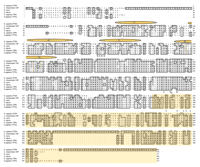Phosphoinositide Phosphatases: Emerging Roles As Voltage Sensors?
Phosphoinositide phosphatases belong to the protein tyrosine phosphatase (PTP) superfamily whose hallmark is a highly conserved active site motif, Cys-Xxx5-Arg (CX5R). Other members of this super-family include the tyrosine-specific, dual specificity, low-molecular-weight, and Cdc25 phosphatases. Cumulatively, these enzymes are key mediators of a wide variety of cellular processes including differentiation, metabolism, motility, growth, and programmed cell death [reviewed in (1, 2)]. The first characterized phosphoinositide phosphatase, PTEN (also termed MMAC1 or TEP1), was initially identified as a tumor suppressor that contained amino-acid sequence similarity to PTPs and tensin (3, 4). Unlike most members of the PTP superfamily, PTEN utilizes the phosphoinositide second messenger phosphatidylinositol 3,4,5-trisphosphate [PI(3,4,5)P3] as its physiologic substrate, producing the signaling lipid phosphatidylinositol 4,5-bisphosphate [PI(4,5)P2]. The active-site motif of PTEN is conserved from Homo sapiens to Schizosaccharomyces pombe and contains the amino-acid residues -His-Cys-Lys-Ala-Gly-Lys-Gly-Arg-. The Cys residue functions as a nucleophile, and mutations at this residue result in a complete loss of phosphatase activity. In addition, the conserved Lys residues are predicted to interact with the phosphate groups on the inositol ring, before phosphotransfer to the substrate.
A genomic survey of Ciona intestinalis by Murata et al. (5) uncovered a gene that encodes a protein sharing regional sequence similarity to both a CX5R phosphatase and an ion channel. Members of the ion channel superfamily contain six transmembrane domains, S1–S6, that are organized into two modules: the sensor (S1–S4) and the pore (S5–S6) (6). The N terminus of the C. intestinalis protein comprises four transmembrane segments (S1–S4, Figure 1⇓), suggesting that this portion of the protein may play a role as a voltage sensor. Intriguingly, the C terminus contains a PTP active-site motif, -His-Cys-Lys-Gly-Gly-Lys-Gly-Arg-; the conserved Lys residues place this enzyme in the PTEN family. The name given to the novel protein––C. intestinalis voltage-sensor-containing phosphatase (Ci-VSP)––reflects the potential roles this enzyme may play in the cell.
Murata et al. (5) provided experimental evidence that the putative transmembrane domains (S1–S4) of Ci-VSP can operate as a voltage sensor in Xenopus oocytes and can do so with or without the C-terminal phosphatase domain. Additionally, data was presented showing that Ci-VSP harbors phosphoinositide phosphatase activity, converting PI(3,4,5)P3 to PI(4,5)P2. This raises the intriguing question: Is the phosphatase activity of Ci-VSP dependent upon the voltage-sensor function?
One way that this could be effected is through activation of the phosphatase activity of Ci-VSP and the subsequent production of PI(4,5)P2 in a localized membrane environment. In addition to their well-characterized roles as second messengers, phospholipids are now appreciated as physiological regulators of ion transporters and channels. Systems activated by PI(4,5)P2 include epithelial sodium channels (7), cardiac sodium-calcium exchangers (8), sodium-proton exchangers (9), and all inwardly rectifying potassium channels [including IRK and GIRK (10–13)]. Alternatively, some systems are inhibited or unaffected by PI(4,5)P2.
Localized changes of PI(4,5)P2 in the membrane could serve to either positively or negatively regulate a variety of ion transporters and channels. Murata et al. (5) chose two different inwardly rectifying potassium (Kir) channels and an M-current K+ channel (KCNQ2/3) to test this hypothesis. Kir3.2 channel (GIRK2) activity is regulated by G protein βγ subunits, sodium ions, and PI(4,5)P2 (10). GIRK2 along with bovine G protein subunits β1 and γ1 was expressed in oocytes with or without Ci-VSP. In the absence of Ci-VSP, the amplitude of the GIRK2 currents (activated by stepping to −100 mV) did not change after repeated pulses. On the other hand, when Ci-VSP was coexpressed with GIRK2 channels, the current amplitude significantly increased after ten-second intervals between test pulses in the hyperpolarized state and decreased over time in the depolarized state. These changes in current amplitude were dependent upon Ci-VSP having both an active phosphatase domain and an active voltage-sensor domain. Constitutively active Kir2.1 (IRK1) channels, which are exquisitely sensitive to PI(4,5)P2, were also used in this study. Coexpression of Ci-VSP and IRK1 channels in oocytes did not result in a change in IRK1 channel activity, presumably because of the sensitivity of IRK1 channels to very small amounts of PI(4,5)P2. When IRK1 channels are mutated (IRKR228Q), they become less sensitive to PI(4,5)P2 and then their activity can be modulated by Ci-VSP expression (13). These results suggest that Ci-VSP activity can increase PI(4,5)P2 levels in the vicinity of the channels and thereby influence the activity of the channel. The authors also tested another type of K+ channel, KCNQ2/3, which underlies M currents and is activated by PI(4,5)P2 (14). The activity of these channels was modulated by wild-type Ci-VSP but not by mutant versions that lacked either the sensor activity or the phosphatase activity. Therefore, in each case, Ci-VSP is presumably able to modulate PI(4,5)P2 levels in a manner that is membrane potential–dependent. Possible mechanisms are schematically depicted in Figure 2⇓ where changes in membrane potential influence the transmembrane segments of Ci-VSP. Induction of an activating conformational change in the phosphatase domain and/or physical repositioning of the phosphatase active site near the membrane phospholipid where it converts PI(3,4,5)P3 to PI(4,5)P2 would lead to the activation of nearby PI(4,5)P2-sensitive channels. As this is the first example of a phosphoinositide phosphatase whose activity is potentially regulated by membrane potential, this theory will have to be rigorously tested.
To identify the mechanism by which membrane potential could influence phosphatase activity, the authors generated two eight amino-acid deletions targeting the linker region that separates the transmembrane domains from the phosphatase domain. The deletion construct targeting the amino acids adjacent to the trans-membrane domain displayed a loss of function with respect to the aforementioned assay, suggesting an important role in coupling the two domains. Alternatively, a deletion of eight amino acids could result in a dramatic change in the orientation of the enzyme with respect to its substrate or in the stability of the enzyme in general, thereby generating the observed results. A more detailed structural and mutational analysis of this enzyme will have to be undertaken in order to understand the mechanism by which membrane potential is linked to phosphatase activity.
Murata et al. (5) observed that Ci-VSP mRNA is abundant in testis (sperm tails) and is present (to a lesser degree) in the neural complex of C. intestinalis. This is intriguing as PTEN2 (murine) and TPTE (transmembrane phosphatase with tensin homology; human) and TPIP (TPTE and PTEN homologous inositol lipid phosphatase; human)––all putative mammalian VSP homologs––are also expressed in testis and neural tissues (15, 16). BLAST analyses of Ci-VSP and related protein sequences results in an alignment (Figure 1⇓) that shows the high degree of conservation maintained from C. intestinalis to H. sapiens. The active-site residues of the PTPase domain are perfectly conserved except in the case of TPTEγ. In TPTEγ, the substitution of Thr304-Asp305 for the highly conserved Lys-Gly is not likely to abrogate enzymatic activity but could alter its specificity for phospholipids. The N-terminal voltage-sensing domain is less highly conserved at the amino-acid level and is completely absent from PTEN. Domain analyses using SMART (Simple Modular Architectural Research Tool; http://smart.emblheidelberg.de/help/smart_glossary.shtml), however, demonstrates that these homologs display structural conservation with Ci-VSP over the S1–S4 transmembrane domains (Figure 1⇓, orange ovals) (17). The Asn-hydrophobic-hydrophobic-Asp (notated as NhhD, in Figure 1⇓) motif located near the beginning of S3 is the most highly conserved stretch of amino acids found in the entire voltage-gated channel (S1–S6) superfamily (6). It is noteworthy that Asn is not conserved in Ci-VSP. Because this motif is not conserved in channels where the sensor module is vestigial in nature [such as in the cyclic nucleotide-gated (CNG) channel and in IP3R], it will be of interest to define the function of these residues in the Ci-VSP family. The Arg residues important for voltage sensing in Ci-VSP are only partially conserved in the other VSP homologs, pointing to the necessity of testing the other family members for voltage-sensing capabilities. The C2 domain is conserved in all the family members (Figure 1⇓, orange box). In PTEN, the C2 domain is important for membrane association, and mutation of critical Lys residues (Figure 1⇓, purple asterisks) results in PTEN’s inability to associate with lipid vesicles (18, 19). These Lys residues are not conserved in the Ci-VSP homologs, which suggests that the C2 domains may have other functions in these proteins that are clearly membrane associated via their transmembrane domains.
The mammalian VSP homologs display an additional level of complexity at the level of alternative splicing (15). The TPTE subfamily contains the transmembrane domains S1–S4, the phosphatase domain, and the C2 domain. Alternative splicing affects the N termini of these proteins. All the splice variants are expressed exclusively in the testis, and subcellular localization places these proteins in the ER–Golgi. Neither the enzymatic activities nor the functions of these proteins are known at this time (20). TPIP is also alternatively spliced, but in this case, some of the splice variants are missing one or more transmembrane domains. This raises the possibility that these proteins that localize to the ER in testis, brain, and stomach could be oriented either toward the lumen of the ER or toward the cell cytoplasm, thereby changing their substrate pool. TPIP is enzymatically active, preferentially removing the 3-phosphate from PI(3,4,5)P3 > PI(3,5)P2 > PI(3,4)P2 > PI(3)P (20). It is not clear which phosphoinositide species are present or what their function(s) are in the ER; therefore, the function of TPIP awaits elucidation. The murine homolog of Ci-VSP, PTEN2, maintains the same active-site residues as found in TPIP but preferentially removes the 3-phosphate from PI(3,5)P2> PI(3,4,5)P3. PTEN2 is found exclusively in the Golgi of secondary spermatocytes, a stage of spermatogenesis preceding the large morphological changes that produce mature sperm. Wu et al. (16) speculate that PTEN2 may function in the process by which the Golgi of the late spermatocyte becomes the acrosome of mature sperm. Indeed, several of the VSP family members are localized to secondary spermatocytes, prespermatids, or both (15). Because very little is known about the cellular functions of these enzymes and the signal transduction pathways in which they participate, future studies may uncover roles for these phosphatases in fertility, making them potential targets for clinical intervention.
Obviously, there is a great deal of work to be done on this interesting PTPase subfamily. The idea that these proteins could be regulating channel activity through modulation of the local PI(4,5)P2 levels is intriguing and precedented. Recently, another lipid phosphatase, phosphatidylinositol 3-phosphate phosphatase myotubularin-related protein 6 (MTMR6) was shown to negatively regulate the Ca2+-activated K+ channel, KCa3.1, owing to its ability to dephosphorylate PI(3)P, an activator of this type of channel (21). It is tempting to speculate that other membrane-associated lipid phosphatases may modulate channel activity by regulating the local concentrations of different phospholipids. This raises the question of how specificity would be generated: will sensor phosphatases be paired with specific channels, each of which could be regulated by the enzymatic product of the phosphatase? MTMR6 does not contain transmembrane domains, thus, targeting to KCa3.1 occurs via an interaction between MTMR6’s coiled-coil domain and the channel’s coiled-coil domain (21). It is possible that VSP family members will be targeted to specific channels or even discrete membrane environments by their C2 domains. This will be an exciting area of future research, lending another level of complexity to the regulation of channels and/or the phospholipid composition of the membrane compartments in which they reside.
Alignment of PTEN with the Ci-VSP family. Amino acid identities are bold and boxed in dark gray whereas conserved amino acids are highlighted in light gray. The four transmembrane domains are indicated by orange ovals and are labeled S1–S4. The Arg residues (R) important for voltage sensing are red. The NhhD and CX5R regions are indicated and the C2 domain is boxed in yellow. The Lys (K) residues in PTEN, important for membrane association, are indicated by dark purple asterisks.
Schematic of potential mechanisms of action of Ci-VSP. The sensor portion of Ci-VSP is shown as dark blue barrels labeled S1–S4 and the phosphatase domain by a light-blue box (inactive) or oval (active). PI(3,4,5)P3 is indicated by red circles whereas PI(4,5)P2 is represented by green circles. The red ovals represent an inwardly rectifying potassium channel (Kir) and the lightning bolt indicates a change in membrane potential and/or conformation. In the absence of a change in membrane shape or potential, Ci-VSP is in its inactive state and the nearby K+ channel is not active. A change in the membrane (lightning bolt) is sensed by the S4 transmembrane domain of Ci-VSP, which then undergoes a conformational change resulting in the activation of the phosphatase. This could occur either by repositioning the phosphatase domain closer to its substrate and/or by changing its conformation thereby activating it. In either case, the localized concentration of PI(4,5)P2 (green circles) in the membrane is increased leading to increased activity of a closely juxtaposed channel.
- © American Society for Pharmacology and Experimental Theraputics 2005
References

Jack E. Dixon, PhD, is the Dean of Scientific Affairs, Professor of Cellular and Molecular Medicine and Professor of Pharmacology at the University of California, San Diego. His laboratory has pioneered studies on the structure and function of the PTPases, as well as determining many of their roles in signal transduction. He is a member of the Institute of Medicine, American Academy of Arts and Sciences, and the National Academy of Sciences.

Carolyn A Worby, PhD, is a Project Scientist in the Dixon laboratory at the University of California, San Diego. Please address correspondence to CAW. E-mail cworby{at}ucsd.edu; fax (858)822-4007.





